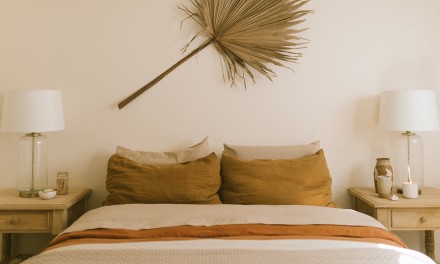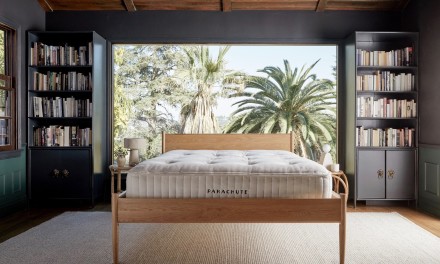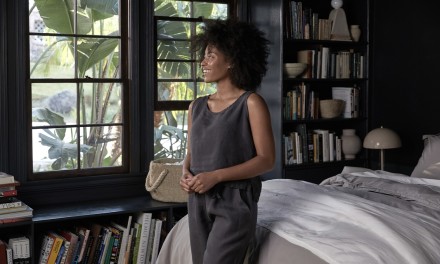We’ve looked to @elanaloo for guidance on everything from sustainability to wellness, creativity and simply how to remain present in the natural world. Like her, we know there’s no place like Mother Earth. Which is why we jumped at the opportunity to work with her when we relaunched and expanded our commitments to sustainability along with our line new of GOTSⓇ-certified Organic Cotton Bedding and lines of Organic Cotton Towels, Robes and Loungewear. Below, Elana shares how she’s incorporated sustainability into her life on the islands and how others can make simple moves to get started or maintain their path.
What inspires you?
Old photo books and magazines. Film photography. The silence and beauty of being underwater or deep in the forest. Herbalism and learning about the human body. People actively taking steps towards making this earth a better place. Natural elements and textures.
What inspires you?
Old photo books and magazines. Film photography. The silence and beauty of being underwater or deep in the forest. Herbalism and learning about the human body. People actively taking steps towards making this earth a better place. Natural elements and textures.
Tell us about your design style
My design style could be described as organic, minimal and leaning more towards timeless than trendy. Pulling in organic elements (linens, palms, shells, ceramics, stone) for texture and shape, well-made secondhand furniture for character and earth tones to mimic the calm energy of nature are ways I try to ground spaces I design. Our home should first belong to the place where it is and then to the people who live in it. Here in the islands, I want to honor this place with subtle nods to our surroundings which are going to look different than anywhere else in the world.
Tell us about your design style
My design style could be described as organic, minimal and leaning more towards timeless than trendy. Pulling in organic elements (linens, palms, shells, ceramics, stone) for texture and shape, well-made secondhand furniture for character and earth tones to mimic the calm energy of nature are ways I try to ground spaces I design. Our home should first belong to the place where it is and then to the people who live in it. Here in the islands, I want to honor this place with subtle nods to our surroundings which are going to look different than anywhere else in the world.
We love how you mix and match linen with our new organic collection – what drew you to this combination?
Mmm linen is my favorite but I love mixing textures on a bed. I think having different types of fabric adds layers and dimension. As you can see, the bed is the focal point of the space and everything else is pretty neutral so adding color, texture, and layers to the bed is a great way to add visual interest without more items in the room.
We love how you mix and match linen with our new organic collection – what drew you to this combination?
Mmm linen is my favorite but I love mixing textures on a bed. I think having different types of fabric adds layers and dimension. As you can see, the bed is the focal point of the space and everything else is pretty neutral so adding color, texture, and layers to the bed is a great way to add visual interest without more items in the room.
What tips can you give for people trying to make sustainable changes in their homes?
First: educate yourself on the WHY. Making change because someone else told you that you ‘should’ never really sticks. To be able to integrate change, we must understand our why and be able to make informed decisions from that place. I have a whole slew of resources for you here to start.
If you’re already there – start by identifying the largest sources of waste in your home. Make a list and start finding low-waste solutions one by one as things run out. For example: if you find yourself constantly throwing away food packaging, identify which are the most common. Maybe yogurt cups or plastic produce bags… try to seek out yogurt in glass and bringing your own cloth produce bags to reuse every time. Repeat this process with all of your largest sources of waste.
Another way to create change is to go room by room. Potentially start with your bathroom…what single-use items can be replaced with reusables (menstrual products, razors, beauty / makeup, etc)? Are there cleaning products that could be replaced with non-toxic alternatives? How about the shower – consider reducing the amount of plastic bottles in there by going package free.
What tips can you give for people trying to make sustainable changes in their homes?
First: educate yourself on the WHY. Making change because someone else told you that you ‘should’ never really sticks. To be able to integrate change, we must understand our why and be able to make informed decisions from that place. I have a whole slew of resources for you here to start.
If you’re already there – start by identifying the largest sources of waste in your home. Make a list and start finding low-waste solutions one by one as things run out. For example: if you find yourself constantly throwing away food packaging, identify which are the most common. Maybe yogurt cups or plastic produce bags… try to seek out yogurt in glass and bringing your own cloth produce bags to reuse every time. Repeat this process with all of your largest sources of waste.
Another way to create change is to go room by room. Potentially start with your bathroom…what single-use items can be replaced with reusables (menstrual products, razors, beauty / makeup, etc)? Are there cleaning products that could be replaced with non-toxic alternatives? How about the shower – consider reducing the amount of plastic bottles in there by going package free.
What’s the best piece of sustainability advice you’ve received?
Progress is the goal – not perfection. Looking back on my journey, I see with 20/20 vision what I couldn’t in the moment… in the initial phase of my environmental awakening, this was just another area of my life to channel my perfectionism. It’s easy to obsess over every little thing and villainize ourselves or think that we’re not participating in change if we aren’t doing all the things. This isn’t true. I love the realization that the world doesn’t need a few people doing zero waste perfectly. What we need is millions of people doing it imperfectly. Start where you are with what you have. Imperfect action is still action.
What’s the best piece of sustainability advice you’ve received?
Progress is the goal – not perfection. Looking back on my journey, I see with 20/20 vision what I couldn’t in the moment… in the initial phase of my environmental awakening, this was just another area of my life to channel my perfectionism. It’s easy to obsess over every little thing and villainize ourselves or think that we’re not participating in change if we aren’t doing all the things. This isn’t true. I love the realization that the world doesn’t need a few people doing zero waste perfectly. What we need is millions of people doing it imperfectly. Start where you are with what you have. Imperfect action is still action.
Are there any misconceptions or myths in the sustainability area we should be aware of?
That living sustainably is expensive – let’s bust this myth once and for all. Buying quality goods or the ‘latest and greatest’ sustainable goods can be a bigger investment, yes, BUT integrating regenerative practices in your life is not expensive.
Using what you already have is the most “sustainable” thing you can do.
Break up with the idea that buying more ________ is the answer or the salve we’re seeking, it’s not. There are an infinite number of ways we can participate without spending (composting, visiting the library rather than shopping new, refusing / stop buying single-use anything, switching to shopping in bulk instead of packaged, reduce factory farmed anything).
Are there any misconceptions or myths in the sustainability area we should be aware of?
That living sustainably is expensive – let’s bust this myth once and for all. Buying quality goods or the ‘latest and greatest’ sustainable goods can be a bigger investment, yes, BUT integrating regenerative practices in your life is not expensive.
Using what you already have is the most “sustainable” thing you can do.
Break up with the idea that buying more ________ is the answer or the salve we’re seeking, it’s not. There are an infinite number of ways we can participate without spending (composting, visiting the library rather than shopping new, refusing / stop buying single-use anything, switching to shopping in bulk instead of packaged, reduce factory farmed anything).
How can we learn from nature?
Nature isn’t separate from us. We are made from the same clay, the same energy, the same molecules, the same magic as everything that surrounds us. I expand upon this idea here. We have been taught and programmed to forget this. We think we ‘go out in nature’ but that’s only so if we’re disconnected from ourselves.
Landscapes, oceans, animals and the cycles of nature have much to teach us as ‘civilized’ people, things we have forgotten. How to regulate our nervous systems, how to find stillness, how to feel ALIVE – it’s all there. We just have to immerse ourselves. Spend time outside as much as possible, in quiet pockets if you can, even better without a phone or any tech distractions. If extended time outside isn’t in the cards for this month or this season, read books on permaculture, on any part of the world that fascinates you, watch documentaries that awe and inspire you. There is so much to learn.
How can we learn from nature?
Nature isn’t separate from us. We are made from the same clay, the same energy, the same molecules, the same magic as everything that surrounds us. I expand upon this idea here. We have been taught and programmed to forget this. We think we ‘go out in nature’ but that’s only so if we’re disconnected from ourselves.
Landscapes, oceans, animals and the cycles of nature have much to teach us as ‘civilized’ people, things we have forgotten. How to regulate our nervous systems, how to find stillness, how to feel ALIVE – it’s all there. We just have to immerse ourselves. Spend time outside as much as possible, in quiet pockets if you can, even better without a phone or any tech distractions. If extended time outside isn’t in the cards for this month or this season, read books on permaculture, on any part of the world that fascinates you, watch documentaries that awe and inspire you. There is so much to learn.
What causes are important to you?
Our world is suffering in a multitude of ways & there are important conversations to be had everywhere. It’s heartbreaking to watch the news or read stories from all over as so many are experiencing atrocities both big and small – ripple effects of war, climate change, social injustice, chemical toxicity, plastic pollution, the list goes on. What we need to acknowledge is the throughlines between these crises we face as a global community. So if your actions involve pulling at one of the many many threads, we’re helping to unravel the whole cloth. We need a shift in global systems to end the continuous suffering of both people and planet.
What causes are important to you?
Our world is suffering in a multitude of ways & there are important conversations to be had everywhere. It’s heartbreaking to watch the news or read stories from all over as so many are experiencing atrocities both big and small – ripple effects of war, climate change, social injustice, chemical toxicity, plastic pollution, the list goes on. What we need to acknowledge is the throughlines between these crises we face as a global community. So if your actions involve pulling at one of the many many threads, we’re helping to unravel the whole cloth. We need a shift in global systems to end the continuous suffering of both people and planet.
What’s next for you?
After a winter of retreat and healing, I'm feeling the vibrant energy of spring boldly (finally) and starting to feel creative ideas stir within myself. As a conscious brand strategist and educator, I have loved the intimacy of 1:1 consulting for years but now more than ever – I feel this deep collective need for community, collaboration and connection.
I am dreaming up some online group offerings that teach creatives, entrepreneurs and small businesses how to build their dreams in a way that sustains – both our spirits and our earthly resources. By stepping into this way of serving, I am hoping to fuse my passion for sustainability and regeneration with my expertise in the entrepreneurial world. *Fingers crossed* it frees some of my time to continue our home projects and build an incredible garden!
Read more on our organic cotton collection here:
Best Organic Bedding: What to Look for in Organic Sheets
Best Organic & Sustainable Bathroom Essentials
What is GOTSⓇ Textile Certification? Everything to Know About GOTS Organic Cotton
What’s next for you?
After a winter of retreat and healing, I'm feeling the vibrant energy of spring boldly (finally) and starting to feel creative ideas stir within myself. As a conscious brand strategist and educator, I have loved the intimacy of 1:1 consulting for years but now more than ever – I feel this deep collective need for community, collaboration and connection.
I am dreaming up some online group offerings that teach creatives, entrepreneurs and small businesses how to build their dreams in a way that sustains – both our spirits and our earthly resources. By stepping into this way of serving, I am hoping to fuse my passion for sustainability and regeneration with my expertise in the entrepreneurial world. *Fingers crossed* it frees some of my time to continue our home projects and build an incredible garden!
Read more on our organic cotton collection here:
Best Organic Bedding: What to Look for in Organic Sheets
Best Organic & Sustainable Bathroom Essentials
What is GOTSⓇ Textile Certification? Everything to Know About GOTS Organic Cotton






